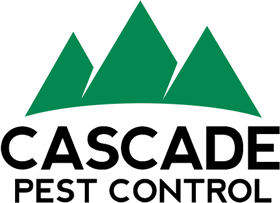Author: Kurt Treftz, Cascade Pest Control
The buzzing, bumbling, building of spring is upon us. As the weather warms and flowers bloom, stinging insects become active as well. And while we can appreciate them in our gardens, we don’t want them in (or on) our homes and businesses.
Washington is home to a number of bees, wasps, and hornets that make their nests in and around human structures. Learn to identify stinging insect nests and keep these painful creatures far, far away.
Stinging Insects in Washington State
Bald faced hornets:
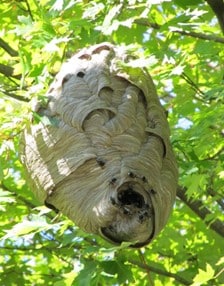
The bald-faced hornet is a stinging insect that builds elaborate nests in trees, eaves, and even attics. While you are likely to only see the insect during warmer months, their nests are often revealed in the winter after the leaves have fallen from the trees. In fact, you might not even know the nest exists until it is abandoned for the winter. (A winter nest is usually uninhabited and will not be reused in the spring. Instead, the overwintering queen will start again in the spring).
Bald-faced hornet nests are papery, grayish with streaks of dark and light waves. It is oblong and built in layers, or tiers, that look like a bee’s honeycomb on the inside. They are usually at least three feet off the ground and often higher – trees and eaves are common locations. The nests can reach over 2 feet long. If it is high up in a tree, you might not need to be concerned about it. If it is closer to human activity, it can be wise to get professional assistance.
Determine if the nest is active or not. You can do this by observing the nest during the heat of the day and seeing whether there are insects going in or out. This will also help you to determine where the entrance is. Then you can decide if you need to remove the nest or not.
These hornets do not have a barbed stinger so they are able to sting multiple times. While the general principle of “live and let live” can work with stinging insects, if you have an allergy to the sting or if it is close to a walkway or entrance, you might want to consider removing them.
European paper wasps:
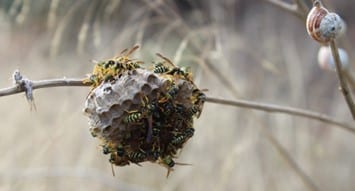
These common wasps are stinging insects that build a paper-like nest. You are likely to see these social insects constructing their nests on tree branches, eaves, outdoor structures like gazebos and pergolas, and even mailboxes.
The queen starts a new nest each season. It hangs from a single filament and looks a bit like a honeycomb (except it is made from a papery substance instead of wax) in an umbrella shape. The comb-like openings are oriented downward in a single layer of hexagonal-shaped cells.
Paper wasps tend to be a bit less aggressive than yellow-jackets or hornets, but they will still sting if provoked. Wasps are pollinators and they also feed on other insects so they are an important part of the natural cycle, but they can be dangerous with their sting so it can be necessary to protect yourself, pets, or property by removing the nests.
Western Yellow Jackets:
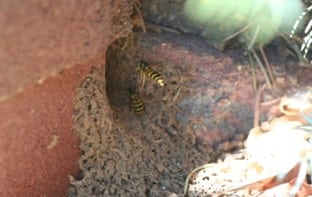
The Western Yellowjacket is a wasp native to regions in North America. It is a social wasp with a distinctive black-and-yellow stripping often with a continuous yellow band around each eye. It prefers temperate climates which is why they are common in the Seattle area.
These ground-dwelling wasps are quite aggressive. Yellowjackets will build their paper nests underground in uninhabited rodent burrows, wood piles, tree cavities, and other enclosed spaces. The nest is usually round and built in layers; it can be home to thousands of workers.
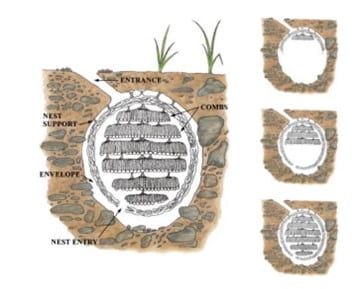
Yellowjackets can be beneficial as the larvae eat other insects and caterpillars (controlling pests) while the adults eat nectar (aid in pollination). However, their presence on the ground can bring them into contact with humans. Like other wasps, these insects can sting repeatedly and those sensitive to their venom may have life-threatening allergic reactions.
Honey Bees:
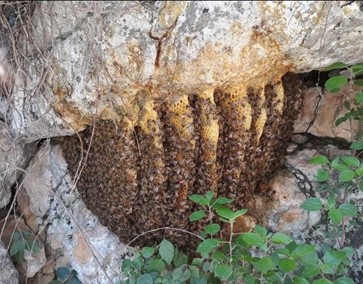
Another stinging insect found in Washington is the honey bee. Unlike their stinging cousins mentioned above, honey bees are less aggressive and they are only able to sting once. The barbed end of their stinger acts like a screw anchor; once stuck into skin it can’t retract. The bee dies when it attempts to yank out the stinger.
However, honey bees are quite beneficial as they pollinate and create honey. Their distinctive nests are made of waxy comb. Each cell holds an egg or developing bee. They are usually white or yellow in color. Honey bees build their nests inside hollows in trees or manmade structures. While pictures and cartoons often show honey bee nests hanging off of tree branches, such nests aren’t quite that common, because they are unprotected. Combs formed in such a situation usually don’t last long and bees will look for a more suitable spot.
Honey bees prefer to build their nests in enclosed areas that are dark and easier to protect. Cavities that attract honey bees need a volume of at least 4 gallons but they prefer 9 gallons.
Honey bees aren’t typically aggressive and usually sting only to defend their nest and young.
Bumble Bees:
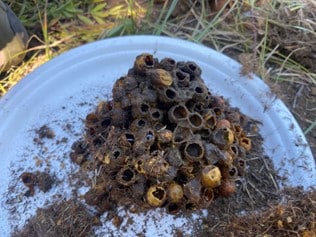
Like honey bees, bumble bees use pollen and nectar to feed and produce honey (although in much smaller amounts – not enough for humans to harvest). They are also furry with black and yellow stripes. But when it comes to nesting the similarities come to an end.
Bumble bee nests are much more haphazard than the strict symmetry of honey bees. Bumble bees use wax but build their nests in a variety of areas from trees to ground or sub-ground. They will also take advantage of other structures like pre-existing holes, gaps in siding, leaf piles, abandoned bird nests, etc. They seize opportunities where they can.
A bumble bee nest will often resemble a pile of trash. Inside, it is lined with insulating materials like leaves or even animal fur. Within these shelters are a few wax cells and honey pots for food. Bumble bee colonies are much smaller than honey bees at only about 400-500 strong. Bumble bees are quite docile and unlikely to sting, while their pollinating activity is extremely beneficial.
Sometimes spring comes with some sting. Stay safe from stinging insects by identifying and avoiding their nests. And contact the wasp control experts at Cascade Pest Control if it gets out of hand.
